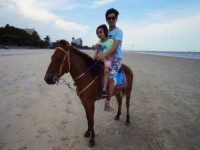动画+TabLayout+ViewPager
来源:互联网 发布:linux 查看网络通不通 编辑:程序博客网 时间:2024/06/05 21:00
这个是需要添加的一些依赖。。。
compile 'com.nostra13.universalimageloader:universal-image-loader:1.9.5'compile 'com.android.support:mediarouter-v7:25.0.0'compile 'com.android.support:appcompat-v7:25.0.0'compile 'com.android.support:recyclerview-v7:25.0.0'compile 'com.squareup.okio:okio:1.5.0'compile 'com.squareup.okhttp3:okhttp:3.2.0'compile 'com.squareup.okhttp3:logging-interceptor:3.4.1'compile 'com.google.code.gson:gson:2.8.2'compile 'com.youth.banner:banner:1.4.9'compile 'com.github.bumptech.glide:glide:3.7.0'compile 'com.orhanobut:logger:1.15'compile 'com.jcodecraeer:xrecyclerview:1.3.2'compile 'com.android.support:design:23.4.0'
首先是主界面的activity登录的界面设置这里是用的自定义属性弄的<?xml version="1.0" encoding="utf-8"?><RelativeLayout xmlns:android="http://schemas.android.com/apk/res/android" xmlns:tools="http://schemas.android.com/tools" android:id="@+id/activity_main" android:layout_width="match_parent" android:layout_height="match_parent" android:paddingBottom="@dimen/activity_vertical_margin" android:paddingLeft="@dimen/activity_horizontal_margin" android:paddingRight="@dimen/activity_horizontal_margin" android:paddingTop="@dimen/activity_vertical_margin" tools:context="com.bwie.test.yuekaomoni.MainActivity"> <com.bwie.test.yuekaomoni.MyView android:layout_width="match_parent" android:layout_height="match_parent" /></RelativeLayout>
这个地方是自定义View的使用:
importandroid.animation.ValueAnimator;
import android.content.Context;import android.graphics.Canvas;import android.graphics.Color;import android.graphics.Paint;import android.util.AttributeSet;import android.view.View;public class MyView extends View { // 设置需要用到的变量 public static final float RADIUS = 30f;// 圆的半径 = 70 private Point currentPoint;// 当前点坐标 private Paint mPaint;// 绘图画笔 // 构造方法(初始化画笔) public MyView(Context context, AttributeSet attrs) { super(context, attrs); // 初始化画笔 mPaint = new Paint(Paint.ANTI_ALIAS_FLAG); mPaint.setColor(Color.BLUE); } // 复写onDraw()从而实现绘制逻辑 // 绘制逻辑:先在初始点画圆,通过监听当前坐标值(currentPoint)的变化,每次变化都调用onDraw()重新绘制圆,从而实现圆的平移动画效果 @Override protected void onDraw(Canvas canvas) { // 如果当前点坐标为空(即第一次) if (currentPoint == null) { currentPoint = new Point(RADIUS, RADIUS); // 创建一个点对象(坐标是(30,30)) // 在该点画一个圆:圆心 = (70,70),半径 = 70 float x = currentPoint.getX(); float y = currentPoint.getY(); canvas.drawCircle(x, y, RADIUS, mPaint); // (重点关注)将属性动画作用到View中 // 步骤1:创建初始动画时的对象点 & 结束动画时的对象点 Point startPoint = new Point(RADIUS, RADIUS);// 初始点为圆心(70,70) Point endPoint = new Point(getWidth()/2, getHeight()/2);// 结束点为(700,1000) // 步骤2:创建动画对象 & 设置初始值 和 结束值 ValueAnimator anim = ValueAnimator.ofObject(new PointEvaluator(), startPoint, endPoint); // 参数说明 // 参数1:TypeEvaluator 类型参数 - 使用自定义的PointEvaluator(实现了TypeEvaluator接口) // 参数2:初始动画的对象点 // 参数3:结束动画的对象点 // 步骤3:设置动画参数 anim.setDuration(5000); // 设置动画时长// 步骤3:通过 值 的更新监听器,将改变的对象手动赋值给当前对象// 此处是将 改变后的坐标值对象 赋给 当前的坐标值对象 // 设置 值的更新监听器 // 即每当坐标值(Point对象)更新一次,该方法就会被调用一次 anim.addUpdateListener(new ValueAnimator.AnimatorUpdateListener() { @Override public void onAnimationUpdate(ValueAnimator animation) { currentPoint = (Point) animation.getAnimatedValue(); // 将每次变化后的坐标值(估值器PointEvaluator中evaluate()返回的Piont对象值)到当前坐标值对象(currentPoint) // 从而更新当前坐标值(currentPoint)// 步骤4:每次赋值后就重新绘制,从而实现动画效果 invalidate(); // 调用invalidate()后,就会刷新View,即才能看到重新绘制的界面,即onDraw()会被重新调用一次 // 所以坐标值每改变一次,就会调用onDraw()一次 } }); anim.start(); // 启动动画 } else { // 如果坐标值不为0,则画圆 // 所以坐标值每改变一次,就会调用onDraw()一次,就会画一次圆,从而实现动画效果 // 在该点画一个圆:圆心 = (30,30),半径 = 30 float x = currentPoint.getX(); float y = currentPoint.getY(); canvas.drawCircle(x, y, RADIUS, mPaint); } }}
在使用自定义View的时候这几个地方也别忘记了。。。
public classPoint {
// 设置两个变量用于记录坐标的位置 private float x; private float y; // 构造方法用于设置坐标 public Point(float x, float y) { this.x = x; this.y = y; } // get方法用于获取坐标 public float getX() { return x; } public float getY() { return y; }}
还有这个也要写不然会报错的
import android.animation.TypeEvaluator;public class PointEvaluator implements TypeEvaluator { @Override public Object evaluate(float fraction, Object startValue, Object endValue) { // 将动画初始值startValue 和 动画结束值endValue 强制类型转换成Point对象 Point startPoint = (Point) startValue; Point endPoint = (Point) endValue; // 根据fraction来计算当前动画的x和y的值 float x = startPoint.getX() + fraction * (endPoint.getX() - startPoint.getX()); float y = startPoint.getY() + fraction * (endPoint.getY() - startPoint.getY()); // 将计算后的坐标封装到一个新的Point对象中并返回 Point point = new Point(x, y); return point; }}
然后在主界面设置一个定时器进行播放完跳转。。。
importandroid.content.Intent;
import android.support.v7.app.AppCompatActivity;import android.os.Bundle;import java.util.Timer;import java.util.TimerTask;public class MainActivity extends AppCompatActivity { @Override protected void onCreate(Bundle savedInstanceState) { super.onCreate(savedInstanceState); setContentView(R.layout.activity_main); new Timer().schedule(new TimerTask() { @Override public void run() { Intent intent=new Intent(MainActivity.this,ShowActivity.class); startActivity(intent); } }, 5000); }}
下面这里要进行的是tab与Viewpager的联动效果。。。
首先就是要在主的界面写的
import android.os.Bundle;import android.support.design.widget.TabLayout;import android.support.v4.app.Fragment;import android.support.v4.app.FragmentPagerAdapter;import android.support.v4.view.ViewPager;import android.support.v7.app.AppCompatActivity;import java.util.ArrayList;import java.util.List;public class ShowActivity extends AppCompatActivity implements TabLayout.OnTabSelectedListener{ ViewPager pager; TabLayout tab; List<Fragment> mFragmet; @Override protected void onCreate(Bundle savedInstanceState) { super.onCreate(savedInstanceState); setContentView(R.layout.activity_show); mFragmet=new ArrayList<>(); mFragmet.add(new Fragment1()); mFragmet.add(new Fragment2()); mFragmet.add(new Fragment3()); mFragmet.add(new Fragment4()); initView(); } private void initView() { pager= (ViewPager) findViewById(R.id.view_pager); tab= (TabLayout) findViewById(R.id.tab_layout); tab.addTab(tab.newTab().setText("Tab 1"));//设置文字 tab.addTab(tab.newTab().setText("Tab 2"));//设置文字 tab.addTab(tab.newTab().setText("Tab 3"));//设置文字 tab.addTab(tab.newTab().setText("Tab 4"));//设置文字 pager.setAdapter(new FragmentPagerAdapter(getSupportFragmentManager()) { @Override public Fragment getItem(int position) { return mFragmet.get(position); } @Override public int getCount() { return mFragmet.size(); } }); /*这个地方是为了添加联动效果的*/ pager.addOnPageChangeListener(new TabLayout.TabLayoutOnPageChangeListener(tab)); tab.setOnTabSelectedListener(this); } @Override public void onTabSelected(TabLayout.Tab tab) { pager.setCurrentItem(tab.getPosition()); } @Override public void onTabUnselected(TabLayout.Tab tab) { } @Override public void onTabReselected(TabLayout.Tab tab) { }}
还有就是要他的布局。。。
<?xml version="1.0" encoding="utf-8"?><LinearLayout xmlns:android="http://schemas.android.com/apk/res/android" xmlns:tools="http://schemas.android.com/tools" xmlns:app="http://schemas.android.com/apk/res-auto" android:id="@+id/activity_show" android:orientation="vertical" android:layout_width="match_parent" android:layout_height="match_parent" tools:context="com.bwie.test.yuekaomoni.ShowActivity"> <android.support.design.widget.TabLayout android:id="@+id/tab_layout" android:layout_width="match_parent" android:layout_height="48dp" android:background="#ffffff" app:tabSelectedTextColor="#FD5055" app:tabIndicatorColor="#FD5055" app:tabTextAppearance="@style/MyTabLayoutTextAppearance" > </android.support.design.widget.TabLayout> <android.support.v4.view.ViewPager android:id="@+id/view_pager" android:layout_width="match_parent" android:layout_height="match_parent" /></LinearLayout>
还有就是要对viewpager设置几个要显示的fragment。。。
<?xml version="1.0" encoding="utf-8"?><LinearLayout xmlns:android="http://schemas.android.com/apk/res/android" android:layout_width="match_parent" android:layout_height="match_parent"> <TextView android:layout_width="wrap_content" android:layout_height="wrap_content" android:text="第一页"/></LinearLayout>
import android.os.Bundle;import android.support.annotation.Nullable;import android.support.v4.app.Fragment;import android.view.LayoutInflater;import android.view.View;import android.view.ViewGroup;public class Fragment1 extends Fragment{ @Nullable @Override public View onCreateView(LayoutInflater inflater, @Nullable ViewGroup container, @Nullable Bundle savedInstanceState) { View view=inflater.inflate(R.layout.fragment_1,null); return view; }}
阅读全文
0 0
- 动画+TabLayout+ViewPager
- ViewPager+TabLayout
- Viewpager+Tablayout
- TabLayout+ViewPager
- TabLayout+ViewPager
- TabLayout+viewPager
- ViewPager+TabLayout
- Tablayout+viewpager
- TabLayout +ViewPager
- tablayout+viewpager
- Tablayout + viewpager
- Tablayout+viewpager
- TabLayout+ViewPager
- Tablayout+Viewpager
- Tablayout+Viewpager
- Tablayout+viewpager
- tablayout +viewpager
- Inflater&TabLayout&ViewPager
- 页面往后台传数据中文乱码解决方法
- IDA 使用笔记
- echarts3标题点击取消显示时保留一项显示
- unit12
- java模板引擎freemarker
- 动画+TabLayout+ViewPager
- 国内外部分开源软件网站
- OPPO R11s重要参数确认:摄像头光圈大升级
- 导入maven项目后 解决pom 文件ojdbc6报错
- Python 生成MySQL 管理员随机复杂秘钥
- structs2
- 【C++】关于typedef的用法总结
- bgpdump的安装与使用
- 单选按钮


